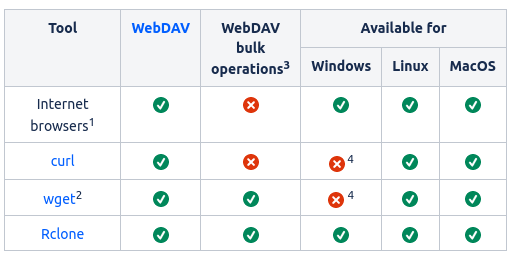Tools
WebDAV is an extension of the HTTP protocol. Therefore, many tasks (browse, download, upload) can be executed using common web/http clients. However, for bulk operations it is advisable to install a special purpose WebDAV client or make use of scripts that hide some of the complexity resulting from working with tokens and directory structures.
The following table provides an incomplete list of clients that can be used to interact with the LOFAR LTA. The WebDAV page on Wikipedia includes a more extensive list of WebDAV clients and more can be found on the internet. However, not all WebDAV applications support Bearer token authentication, which is required to use Macaroons. For example, CyberDuck and WinSCP may not currently support Bearer tokens and are therefore not usable for working with the LOFAR LTA. For bulk operations, it is recommended to install and use the rclone client.

1 Internet browsers primarily process HTML that is retrieved using HTTP requests. The dCache WebDAV service generates HTML for viewing and downloading its content.
2 wget primarily fetches content using HTTP requests but includes functionality to parse the retrieved content for included links. This feature allows e.g. (recursive) retrieval of WebƒDAV directories.
3 Bulk operations include (recursive) downloading of directory content - this requires a macaroon that includes 'LIST' capabilities.
4 These tools have been (re-) ported to also work under Windows but are not natively developed for it. Installation and execution under Windows may require extra steps or have limitations. Check the respective websites for details.
Working with internet browsers
Browsing LTA content will only work with a macaroon that includes authorization to 'LIST' paths. If a directory path is entered for a macaroon without 'LIST' authorization, the browser will show an 'Access Denied' message.
The macaroons generated by StageIT does not include 'LIST' authorization so this method is not applicable
Working with curl
Curl is included in most standard Linux and macOS installations. It provides a basic but powerful command-line tool for issuing HTTP and WebDAV commands. Curl lends itself well for inclusion in shell scripts. Some useful examples are provided below. More information can be found in the man-page and on the internet.
Setting up
There is no real need for setting anything up but when working with macaroons, it is convenient to store the (valid) macaroon in an environment variable. In the examples it is assumed that the MAC environment variable has been set to contain the macaroon:
export MAC=<your-macaroon>
The macaroon needs to be provided to the curl command for inclusion in a special purpose authorization header that will be associated with the request.
Usage
If the path provided in the commands below points to a directory in dCache, curl will return the html code that dCache generates for web-browsing.
Download a file and store it in a local file with the name <my-local-file>:
curl -H "Authorization: bearer $MAC" https://webdav.grid.surfsara.nl:2882/pnfs/grid.sara.nl/data/lofar/ops/projects/<my-path>/<my-file> -o <my-local-file>
Download a file and store it in a local file with the same name as the remote file:
curl -H "Authorization: bearer $MAC" https://webdav.grid.surfsara.nl:2882/pnfs/grid.sara.nl/data/lofar/ops/projects/<my-path>/<my-file> -O
Getting webdav urls
The convert2webdav endpoint provides webdav urls for the files in the staging request. (i.e. https://sdc.astron.nl/stageit/api/staging/requests/{id}/convert2webdav). To download files from these urls, Use curl's -L flag to follow redirects.
curl -L -H "Authorization: bearer $MAC" <webdav url> -O
Working with wget
In comparison with curl, wget is limited to retrieving content from web servers only, but it has more options to fetch lists of files or to e.g. recursively retrieve content that is stored in directories. This requires a macaroon that grants 'LIST' access. Some useful examples are provided below. More information can be found in the man-page and on the internet.
Setting up
There is no real need for setting anything up but when working with macaroons, it is convenient to store the (valid) macaroon in a configuration file for wget. By default, wget will look for a configuration file .wgetrc that is stored in the user home directory. The macaroon can be included in it as follows.
header=Authorization: bearer <Macaroon>
Be aware that wget will always use the configuration file if it is stored in the default location, also for requests to other websites, and that may lead to undesirable behaviour.
It is possible to point wget to a configuration file stored in a custom location by adding the command-line parameter --config=<path-to/config-file>.
Alternatively, the macaroon can be provided on the command-line by adding the option --header "Authorization: bearer <Macaroon>" (in which case setting the macaroon in an environment variable may be more convenient, see the section on curl for more information).
Usage
Download a file and store it in a local file with the same name as the remote file: (info) If the path provided in the command below points to a directory in dCache, wget will return the html code that dCache generates for web-browsing.
wget --config=<config-file> https://webdav.grid.surfsara.nl:2882/pnfs/grid.sara.nl/data/lofar/ops/projects/<my-path>/<my-file>
Download all files for which the URLs are contained in <url-file> (one URL per line):
wget --config=<config-file> -i <url-file>
Recursively download all content from <my-path> (info) Requires a macaroon that grants 'LIST' access.
The StageIT macaroon does not provide 'LIST' access, so not applicable
Working with rclone
Rclone is a particularly powerful, and the recommended, client tool for working with macaroons and WebDAV data in bulk. However, to benefit from its capabilities a macaroon with at least 'LIST' authorization is needed.
The macaroons generated by StageIT does not include 'LIST' authorization so this method is not applicable
Conclusion
Use curl or wget to retrieve the staged data in combination with the provided macaroon.